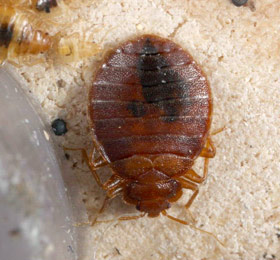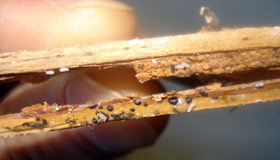Bed Bug, Cimex lectularius

Bed bug (Cimex lectularius) adult with nymphs. Photo by Gary Alpert, Harvard University, Bugwood.org.
IPM Steps to Reduce Bed Bugs
1. Sample for Pest
Where to find it while inspecting: In schools, one sighting of a bed bug does not mean an infestation. Bed bugs may have entered the building on clothing or belongings. You must determine if there is an infestation—meaning that bed bugs are reproducing in school by finding a blood meal source, which is not common, as they feed at night. Inspect furniture, carpeting, and fixtures attached to walls, as these are the most likely places bed bugs will hide. Also check baseboards, behind outlet covers, loose wallpaper, drapery, drawers, and cracks in walls. The first sign is usually fecal stain, which is generally tan to dark brown in color (it is digested blood). Bed bugs tend to cluster together, with various stages of the life cycle staying together. In an infested site, you will also see cast skins along crevices. Examine the room thoroughly, radiating out from any sighting spot, looking along seams, between folds of fabric, and under cushions.
2. Proper ID
Size and Particulars: Adults are 1/4–3/8" pale brown to reddish brown, wingless, and flat bodied before feeding. After feeding they are bloated and dark red. Nymphs (immatures) are lighter and smaller.
3. Learn the Pest Biology

Bed bug (Cimex lectularius) eggs and fecal matter on carpet tack strip. Photo by Mohammed El Damir, Pest Management, Bugwood.org.
Life Cycle: Long, tube-shaped white eggs may be found in clusters of 10–50 eggs. Newly hatched are colorless. If blood sources are accessible, an infestation will begin and support bed bugs throughout their life cycle: Eggs to nymphs (five molts/instars) to adults in about 3 weeks if blood is available to each, and mature adults will mate again during an average lifespan of 10–12 months. As an indoor pest dependent only on food supply, there is no “season” involved.
Preferred Food Sources: Blood—human preferably but not exclusively.
Preferred Habitat: Dark, undisturbed areas with moderate temperatures within close proximity to nighttime food source—this is one reason that bed bugs may be found in schools but not often thriving, though they only need a few minutes to feed before dropping off and returning to their hiding place.
4. Determine Threshold
Threshold: Correctly identify any suspected bed bug before overreacting. Take action to inspect. A bed bug found in school does not mean an infestation until you find evidence of feeding bed bugs successfully reproducing.
5. Choose Tactics
Best Management Practices: Reduce clutter and the use of upholstered furniture and blankets in areas where bed bugs have been found—especially an actual infestation. Clean and remove any bedding into plastic bags if infested and follow procedures to wash, heat treat or discard. Remove carpeting, and correct ill-fitting baseboards, wallpaper and outlet covers that might create harborage.
Treatment Methods: No chemical treatment is needed unless there is a huge infestation and that is very unlikely in most schools. However, actions can be taken to end an infestation and prevent future ones: Clean and declutter! Remove clutter and clean well, vacuum habitat areas well, daily (carpets, bedding, upholstered furniture) and get into crevices and folds. Concentrate on seams, folds and creases. Wash bedding and blankets; heat treat pillows, stuffed animals, etc.
6. Evaluate
Was the tactic successful? Record the date pests were first noted, and the tactic you used, and its success. Use one of our recordkeeping tools.
For More Information
Bed Bugs Are Back! An IPM Answer
NYC Department of Education Bed Bug Kit
Remember:
When a pesticide application is necessary, all necessary and required precautions are taken to minimize risk to people and the environment and to minimize risk of pesticide resistance or pest resurgence. Pesticide use in your school may be prohibited or regulated by local policies or state and federal regulations. Risk reduction methods can include, but are not limited to, spot-treatment, the use of gel or paste bait formulations placed in inaccessible locations, injection into a crack or crevice, and other methods that reduce potential exposure.